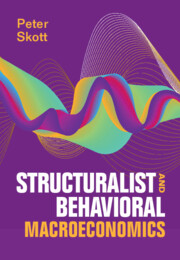Book contents
- Frontmatter
- Contents
- Figures
- Preface and Acknowledgments
- 1 Introduction: The State of Macroeconomics
- 2 The Lucas Critique and Representative Agents
- 3 Household Consumption and Saving
- 4 Saving in a Corporate Economy
- 5 Phillips Curves and the Natural Rate of Unemployment
- 6 Fairness, Money Illusion, and Path Dependency
- 7 Earnings Inequality, Power Bias, and Mismatch
- 8 Macroeconomic Adjustment and Keynes’s Instability Argument
- 9 Growth and Cycles
- 10 Endogenous Growth Cycles with or without Price Flexibility
- 11 Secular Stagnation and Functional Finance
- 12 Concluding Comments: Evidence-Based Macroeconomics and Economic Theory
- References
- Author Index
- Subject Index
9 - Growth and Cycles
Published online by Cambridge University Press: 10 November 2023
- Frontmatter
- Contents
- Figures
- Preface and Acknowledgments
- 1 Introduction: The State of Macroeconomics
- 2 The Lucas Critique and Representative Agents
- 3 Household Consumption and Saving
- 4 Saving in a Corporate Economy
- 5 Phillips Curves and the Natural Rate of Unemployment
- 6 Fairness, Money Illusion, and Path Dependency
- 7 Earnings Inequality, Power Bias, and Mismatch
- 8 Macroeconomic Adjustment and Keynes’s Instability Argument
- 9 Growth and Cycles
- 10 Endogenous Growth Cycles with or without Price Flexibility
- 11 Secular Stagnation and Functional Finance
- 12 Concluding Comments: Evidence-Based Macroeconomics and Economic Theory
- References
- Author Index
- Subject Index
Summary
The neoclassical aggregate production is ubiquitous in the macroeconomic literature, despite the theoretical weaknesses exposed by the Cambridge capital controversy. This chapter gives an overview of the controversy and subsequent attempts to provide an empirical justification for the aggregate production function. These attempts are unconvincing, and the function is not needed to explain the reconciliation of the natural and warranted growth rates in mature economies. Kaldor's neo-Keynesian models and an older Marxian tradition explained this outcome by endogenizing the distribution of income and assuming that the saving rate is increasing in the profit share. But capitalist economies contain both stabilizing and destabilizing forces. Depending on the balance of these forces, the result may be endogenous cycles, as in Goodwin’s formalization of Marx’s general law of accumulation. This model has weaknesses, but the presence of endogenous cycles is in line with empirical studies which find evidence of local instability.
Keywords
- Type
- Chapter
- Information
- Structuralist and Behavioral Macroeconomics , pp. 228 - 255Publisher: Cambridge University PressPrint publication year: 2023

